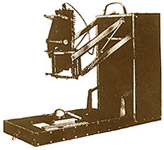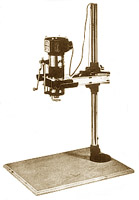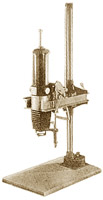|
In
1935, small format cameras such as Leica and Contax were becoming
quite popular. Young Fred Simmon believed that there was a market
for a domestic enlarger to compete with the Leica. He enlisted his two older brothers, Rudolph and Alfred, to
join him in a venture to produce a new enlarger.
 Alfred
was then employed as an engineer with Westinghouse, and did the
design work of the enlarger at night and on weekends. Simmon Bros.
first enlargers were ready to sell in the spring of 1936. The
initial product was quite ambitious - a 35mm enlarger, complete with
adjustable 8x10 easel, safelight, timer, and magnifier for focusing,
that folded up into a compact carrying case. Looking for a
trademark for their products, they felt the Greek letter Omega
sounded good and would make a suitable logo, and registered it with
the Patent Office. Alfred
was then employed as an engineer with Westinghouse, and did the
design work of the enlarger at night and on weekends. Simmon Bros.
first enlargers were ready to sell in the spring of 1936. The
initial product was quite ambitious - a 35mm enlarger, complete with
adjustable 8x10 easel, safelight, timer, and magnifier for focusing,
that folded up into a compact carrying case. Looking for a
trademark for their products, they felt the Greek letter Omega
sounded good and would make a suitable logo, and registered it with
the Patent Office.
That first enlarger, called "The
Complete Enlarger," proved to be a little too ambitious, as they
found they were losing money on each unit they sold, and quickly set
about to design a less complicated, lower priced unit. In 1937, they
introduced the "Omega B" enlarger, which accepted negatives up to
2¼"x2¼". Priced at $65.00 without lens, it gained immediate
acceptance with dealers and customers, thus assuring the success of
the young company.
design a less complicated, lower priced unit. In 1937, they
introduced the "Omega B" enlarger, which accepted negatives up to
2¼"x2¼". Priced at $65.00 without lens, it gained immediate
acceptance with dealers and customers, thus assuring the success of
the young company.
In 1938, a
35mm enlarger, the "Model A," based on the design of the "Model B,"
was added to the line. By that time, Alfred had been able to leave
Westinghouse and join his brothers as an equal partner in the firm.
1939 proved
to be another pivotal year for Simmon Bros. In August of that year,
Kodak announced their forthcoming 2¼x3¼ "Precision Enlarger," which
boasted more features and accessories than the "Omega B." The
brothers feared that the new enlarger, backed by Kodak's huge
marketing and promotional resources, would put them out of
business. With a massive effort, they designed and built the "Super
Omega B" enlarger in just three months. It debuted only a few weeks
after Kodak's initial shipments, and sold well enough that Kodak
dropped the "Precision Enlarger" after several years.
 In
that era, Speed Graphic cameras, using 4"x5" film were the news
photographers camera of choice. It was logical, therefore, for
Omega to have an enlarger that would accommodate this film size, so
the "Model D" was also introduced in 1939, followed by the famous
D-II just two years later. In
that era, Speed Graphic cameras, using 4"x5" film were the news
photographers camera of choice. It was logical, therefore, for
Omega to have an enlarger that would accommodate this film size, so
the "Model D" was also introduced in 1939, followed by the famous
D-II just two years later.
During World
War II, production of enlargers for civilian use was prohibited, so
the future of their 20 employees was in doubt. The company managed
to secure contracts with the Army Signal Corp, which helped, but did
not fully occupy the workforce. They then approached and were
welcomed by the U.S. Navy to produce 5"x5", 7"x7" and 10"x10"
enlargers. Additionally, the company was commissioned to design a
2¼"x3¼" pack film camera to meet Navy requirements for combat
conditions. The experience gained on this project eventually led to
the production of what became the Rapid-Omega roll film camera,
which introduced the 6x7cm format.
The Simmon
Bros. factory was in an ideal position to quickly resume production
of consumer enlargers after the war, and found that the largest
market was now for 4x5 enlargers, primarily due to returning GIs who
had worked in military darkrooms.
The Omega
factory continued to thrive during the 1950's, introducing the A2, a series
of "B" enlargers, including autofocus versions, an
improved D2, the autofocus D3, 5x7 and 8x10 models, and Chromega
colorheads. By the 1960's Rudolph and Alfred were in their '60s, and
the brothers looked to assure the future of Omega. In 1964,
therefore, Simmon-Omega became a division of Berkey Photo.
It was during
this period that the company benefited from a major boom in interest
in photography. The 35mm SLR, with built-in metering systems
simplified the process of achieving quality photographs and widened
the appeal of photography as a hobby. Later on the introduction of
colorhead enlargers and color processing drums enabled anyone to
conveniently process their own color enlargements in home
darkrooms. As a result, the sales of darkroom equipment skyrocketed
as well. This enabled Omega to introduce a number of new models
during the 1970's and early 80's, including the D5, C67, B66, B600, C760
and D5500.
Inevitably
there was a downturn. The introduction of one-hour photo labs,
video cameras, point-and-shoot 35mm cameras, and eventually, digital
photography, all have had a negative effect on enlarger sales. The darkroom
market overall declined as hobbyists turned to other interests. In the late
1980s, Berkey Photo experienced financial difficulties and went into
bankruptcy. Omega was subsequently purchased by the RT Corporation
to become RT/Omega. There were more changes as the company
attempted to deal with the changing market. It became Omega
International, then, with the acquisition of Arkay Corp., Omega/Arkay. During this era, the company
engineered proposed new 4x5 enlargers with electronic autofocus systems,
and a new, less expensive 10x10 enlarger. Prototypes were built,
but in the end these projects were abandoned as not commercially
viable, so ultimately there were no new enlarger models
introduced subsequent to the Berkey period.
In 1995, Arkay was
sold back to its previous owners, and
Omega purchased the Satter Corporation to form Omega/Satter. The demand for new enlargers
continued to decline into the new millennium as OmegaSatter were
expanding the other side of their business, the distribution of
photographic accessories. OmegaSatter acquired Brandess/Kalt in 2010 to become the
current company, Omega/Brandess. As the enlarger market
continued to shrink, eventually the decision was made, and quietly,
without any formal announcement, and after more than 75 years,
production of Omega enlargers was halted.
While the Simmon brothers are long gone, their
legacy survives in the thousands of Omega enlargers still in use
today. |

